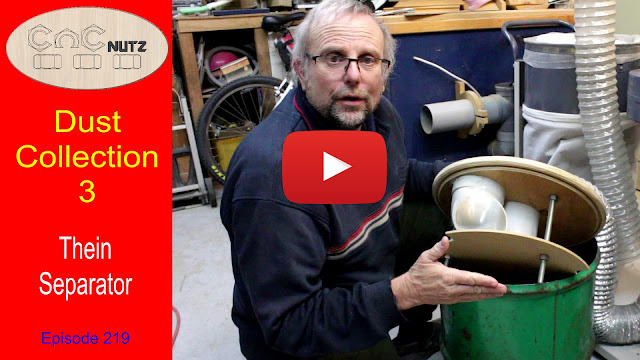Continuing on from the hose install I am now moving to the Dust collector itself. I own a 1hp basic dust collector with the standard ba at the bottom and a filter bag at the top. While it works well it is a bit of a hassle to empty the bottom bag as well as clean out the filter bag. One option is to install a cyclone inline with the DC hose and have it filter out most of the dust before it reaches the dust collector. Unfortunately I do not have the room for such an installation in my workshop. I want everything to be compact and reamin within the footprint of the existing Dust Collector. To put it another way i want it all.
With a Cyclone out of the question I decided to install a Thein Separator. It is basically a compact version of a cyclone which can collect most of the dust and woodchips before they get to the DC. No cyclone is 100% efficient and due to the compromises employed in the Thein separator design it is less effective than a properly designed cyclone. Some people may argue different but given the simple design and compact nature of the Thein, if it really was better than a cyclone, it would have replaced them years ago.
This is my take on a Thein Separator designed to fit under the Dust Collector.
Materials used
Made from a cut down 65 litre (17 US gal) oil drum. It was cut down to just fit under the DC. The plastic parts are a piece of 100mm water pipe and a 100mm 90 degree elbow. Mine is a bit beaten up as it was previously used on another project. There are 3 lengths of threaded rod to hold the baffle in place. the rods are longer than needed to allow the baffle to be positioned further down if needed. By moving the baffle up and down I should be able to fine tune the separator for the best performance. the top is cut from 22mm (7/8) plywood and the baffle from 4.75 (3/16) MDF. Having learnt my lesson with the vacuum table build I avoided MDF as the top of the unit due to how porous MDF is.
The down side
You don't get something for nothing and this is no exception. The introduction of the separator between the DC and the hose will introduce an inevitable loss of vacuum. This is true of any cyclone system. I can see a reduction in vacuum at the dust shoe as the bristles no longer pull in when the vacuum comes on. MY DC is a bit on the weak side and it has difficulty lifting larger chips. Unless the brush is sitting so that it seals to the table or stock it will usually not lift the chips very well. These chips are usually picked up as the cut proceeds and the dust shoe gets lower. The obvious solution is the get a bigger DC with more power but is it really? My thoughts are that so long as the dust is collected then I'm pretty happy. Chips aren't a problem and will be picked up a bit later on in the machining so no problem. It's the dust that really concerns me. It isn't good for the lungs and it floats around the room until it settles over everything from one end of the workshop to the other. The DC in my setup takes more power to run than all the rest put together and getting a DC twice the power and running it for hours on end to do what my smaller more economical unit will do eventually seems a waste to me. Just my thought and the fact that I don't have the room for one that size settles it for me.
How does it work?
I haven't had a chance to really test it yet but a quick test had it picking up dust and chips as expected. I think it will prove to be a worth while addition to my DC. If at the end of the day it isn't sucessful, I can simply connect the hose direct to the DC and bypass it. Only time will tell how well it will work for me.
More information
The Thein separator was designed by Phil Thein and here is the original website showing his design.
http://www.jpthien.com/cy.htm
A great video of a see through Thein separator in action.
https://www.youtube.com/watch?v=3QCAOwSqrko
As usual thanks for taking the time to read and watch and I'll catch you next time.
Cheers
Peter

